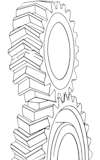also known as double helical gears, overcome the problem of axial thrust
presented by single helical gears by having teeth that set in a 'V'
shape. Each gear in a double helical gear can be thought of as two standard,
but mirror image, helical gears stacked. This cancels out the thrust since
each half of the gear thrusts in the opposite direction. They can be
directly interchanged with spur gears without any need for different
bearings.
Where the oppositely angled teeth meet in the middle of a herringbone
gear, the alignment may be such that tooth tip meets tooth tip, or the
alignment may be staggered, so that tooth tip meets tooth trough. The latter
type of alignment results in what is known as a Wuest type
herringbone gear.
With the older method of fabrication, herringbone gears had a central
channel separating the two oppositely-angled courses of teeth. This was
necessary to permit the shaving tool to run out of the groove. The
development of the Sykes gear shaper now makes it possible to have
continuous teeth, with no central gap.
